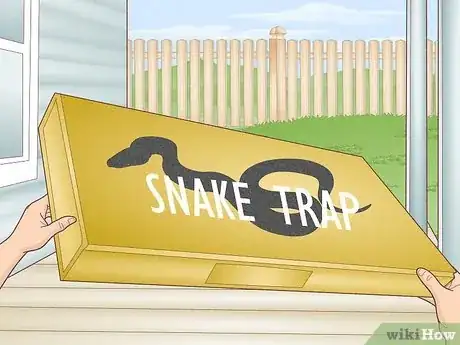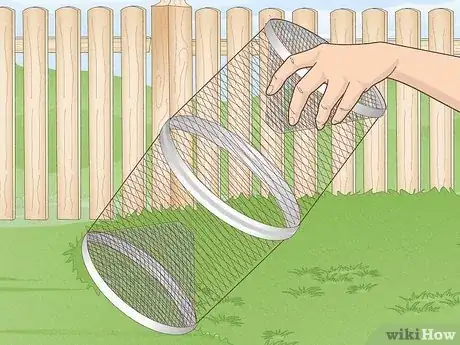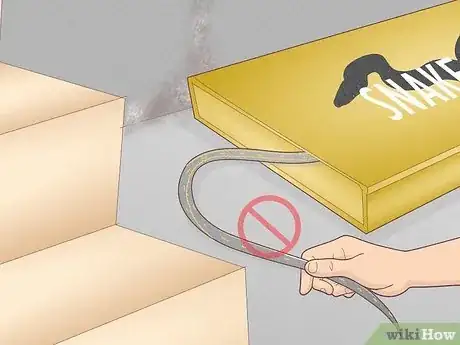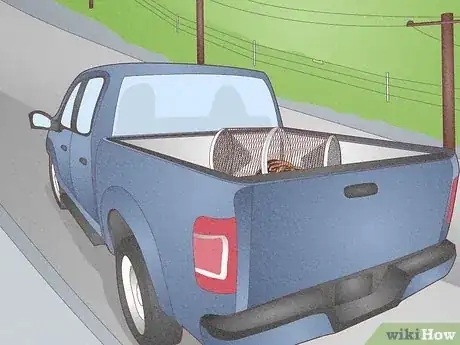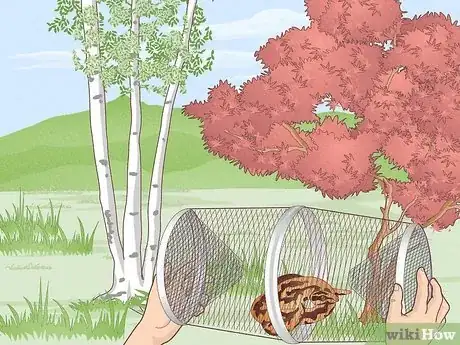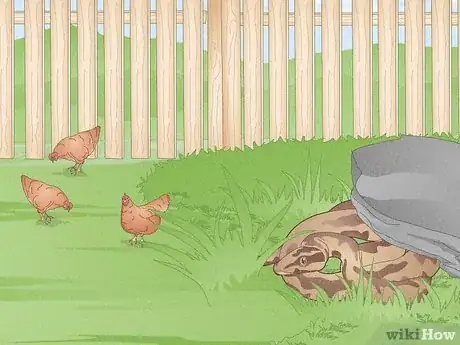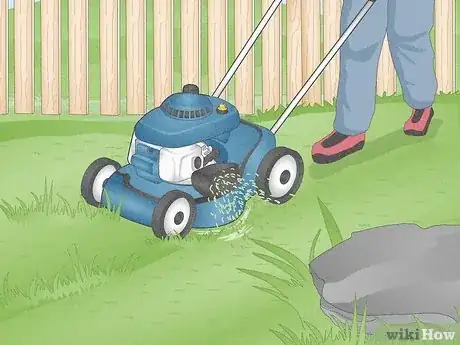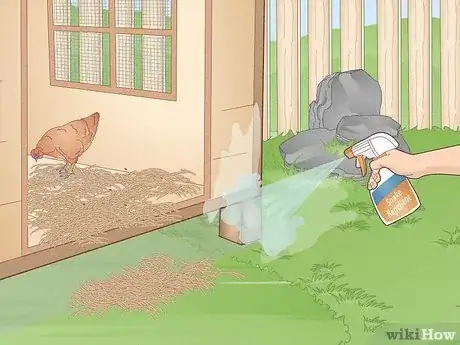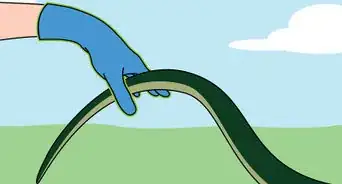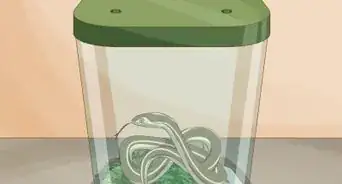This article was co-authored by Chris Parker. Chris Parker is the Founder of Parker Eco Pest Control, a sustainable pest control service in Seattle, Washington. With over seven years of experience, Chris specializes in Integrated Pest Management and doesn’t use any chemicals for pest removal. He offers removal services for ants, rodents, fleas, spiders, wasps, and more. Chris is a certified Commercial Pesticide Applicator in Washington State and received his bachelor’s from the University of Washington.
There are 7 references cited in this article, which can be found at the bottom of the page.
wikiHow marks an article as reader-approved once it receives enough positive feedback. This article has 11 testimonials from our readers, earning it our reader-approved status.
This article has been viewed 318,649 times.
If there's a snake hanging around your garden, basement or chicken coop, trapping it and releasing it somewhere else is an effective and humane way to handle the situation. You can trap a snake using a high-tech snake trap, or get a cheaper minnow trap and bait it with eggs - it works just as well. This article will explain how to trap a snake and what to do with it next.
Steps
Using a Trap
-
1Identify the snake if you can. If you've already spotted the snake (or snakes) you intend to trap, it's a good idea to identify the species so you know what you're getting into. This will help you pick out the right trap and decide how gingerly you need to treat the snake once it's in your care. You can trap venomous snakes on your own, but you should take extreme caution when doing so. If you have kids and pets around and are worried that someone might get bitten, you can always call animal control to come and catch the snake for you.
- There are four types of venomous snakes in North America: rattlesnakes (common in the Western states and identifiable by their rattles), copperheads (copper and black-striped) water moccasins (found in rivers and streams in the Southeastern US) and coral snakes (extremely rare snakes with a brightly-colored coral pattern).[1] Rattlesnakes, copperheads and water moccasins are all pit vipers, and they share a few characteristics: they have thick bodies, triangular heads that are larger than their necks, and vertical pupils instead of round ones.
- Most snakes you'll encounter in the backyard or basement are nonvenomous and completely harmless. Finding a 5-foot king snake in the basement will almost certainly be alarming, but they pose no danger to humans or pets. Nonvenomous snakes do not have rattles, and they have round pupils. Common nonvenomous snakes you might encounter in a home environment include king snakes, rat snakes, garter snakes, gopher snakes, milk snakes and corn snakes.[2]
-
2Get a glue trap. This is the most common type of trap used to catch snakes, and it's both effective and humane. Traps come in small or large sizes, and they generally look like boxes that you set up where you commonly see the snake you're trying to trap. Snake traps usually come with bait already installed to lure the snake inside. When the snake crawls in, it will get stuck to the glue lining the floor of the trap. When a snake is caught, you open the trap and pour oil over the snake so it can get loose and glide away.[3]
- You should be able to find a glue snake trap in your local home and garden supply store. Make sure to pick out a trap that's big enough to contain the snake.
- There are several different glue trap brands, but they all work essentially the same way. The trap itself might be made of either heavy duty cardboard or plastic. Some traps are reusable, while others are single-use. Some let you release the snake, while others are designed to let you throw the snake away without opening the trap.
Advertisement -
3Try a minnow trap. This is a good alternative if you have a lot of snakes to deal with and you don't want to have to purchase new glue inserts for a glue trap.[4] Minnow traps are made of wire mesh and are cylindrical in shape, with holes at either end that invert inside the trap.[5] Just put a few eggs inside to use as bait. The snake will crawl into one of the holes to get the eggs, but it won't be able to find its way out.
- Minnow traps are pretty inexpensive and easy to come by. Look for one at your local fishing supply store.
- The only drawback to using a minnow trap is that you have to bait it yourself, and it's a little more difficult to deal with the snake once you catch it, since the snake can crawl away as soon as you open up the trap. For this reason a minnow trap is probably best used to catch nonvenomous snakes.
-
4Set the trap in a strategic place. Whichever trap you use, set it up in an area where you've seen snakes before. Common places to set up traps include garden areas, the basement, the attic, or the chicken coop. There's no need to camouflage the trap - just set it up in an area that's highly trafficked by snakes.
- Make sure the trap is firmly closed when you set it. If you're using a glue trap, be sure the latch that closes the box is clasped.
- If you're using a minnow trap, set it up so that the cylinder is resting on its side, and place the eggs in the center of the trap.
-
5Check the trap often. Once you catch a snake, you'll want to deal with it as soon as possible. Don't let it die in the trap. This is both inhumane and unsanitary, since the snake will quickly begin to rot. Check the trap every day to see if you've caught something.
- If you're using a glue trap, you might be able to open the top of the box to see if there's a snake inside. Be very careful when you're undoing the latch. You can also tell by lifting the trap to see how heavy it is.
- If you're using a minnow trap, the snake will likely be in plain view, coiled around the eggs, patiently waiting for you to release it.
Dealing With the Snake
-
1Don't attempt to touch the snake. If you're really familiar with snakes, and you know that what you've caught is a garter snake or another nonvenomous snake, you might be able to get away with touching it. But if you're at all unsure what type of snake you've caught, don't take the chance. Wild snakes don't much like to be handled, anyway. Gently carry the entire trap to your vehicle and put it in the trunk or another enclosed area so you can transport it.
- Don't shake the trap or poke at the snake. Handle it with care.
- You might want to keep small children and pets away from the trap while you're handling it, just to be on the safe side.
-
2Drive at least a mile from your house. If you let the snake go too close to your house, it will find its way back to its home territory. Release the snake at least a mile from your home if you want to make sure it doesn't come back. However, if you trapped the snake in your house and you don't mind if it lives outdoors in the yard, you can just walk outside to release it there.
-
3Go to a natural area without many residences nearby. The snake will have the best chance at surviving without disturbing other people if you release it in a natural area. Go to a state park or another area without a lot of people living close by to release the snake. This way it won't end up in someone else's garden.
-
4Free the snake. Freeing a snake is not usually dangerous; in most cases, the snake will be happy to slither away and leave you alone. But just in case, wear long pants and gloves when you're freeing the snake. Watch the snake carefully and be ready to move out of the way if it decides to strike. Depending on which kind of trap you used, there are two different ways to free a snake:
- If you used a reusable glue trap, unlatch the lid of the box and open it up. Pour vegetable oil over the snake's body, making sure to cover the entire are that's attached to the glue. The trap is designed so that the snake will be able to wiggle free from the glue once the oil gets between the snake's skin and the bottom of the trap. By this time you should be standing a fair distance from the trap so you aren't blocking the snake as it leaves the scene.
- If you're using a minnow trap, put on a pair of heavy gloves, since you'll have to get a bit closer to the snake (though you still won't have to touch it). Carefully open the two sides of the trap to separate them at the middle. Leave just enough space for the snake to crawl out. Move away so you aren't in the snake's path when it crawls out.
-
5Kill the snake only as a last resort. All snakes, even venomous snakes, play an important role in their ecosystems and should be released if possible.[6] But if the snake is venomous and you're concerned that someone could get harmed by it, you killing it might be the answer.
- If you used a cardboard glue trap, you can just put the whole thing in a garbage bag and seal it up.
- If you use a minnow trap, you can place the entire trap underwater for a few hours before opening it.[7]
Controlling the Snake Population
-
1Consider letting nonvenomous snakes stick around. While it can be surprising to encounter a snake while weeding your garden or walking around your yard, having a snake around isn't necessarily a bad thing. In fact, you should be proud - a good snake population in an area is a sign that the ecosystem there is healthy. In addition, snakes play an important role in keeping other pests, like mice and rats, from taking over. So if a snake isn't eating your chicken's eggs or otherwise being a bother, consider sharing your yard with it instead of trapping it and moving it elsewhere.
- Rat snakes and gopher snakes are especially beneficial to have around. They're as good as cats for keeping the rodent population down.[8]
- King snakes go one step further and eat rattlesnakes. In fact, if you get rid of a king snake, the rattlesnakes are more likely to move in - and then you'll have a much more serious problem on your hands.
-
2Make your yard less hospitable to snakes. If you don't like snakes, a great way to keep them away is to make your yard less snake-friendly. Snakes hang out in areas that are a little unkempt and wild. They like tall grass, brush piles, wood piles, and other sources of shelter. To make your yard less inviting, do the following:
- Mow the lawn regularly.
- Get rid of piles of rocks, leaves, brush, bricks, or anything else that a snake could use as shelter.
- Keep your rodent population down by cleaning up acorns, sealing your trash, and removing other sources of food for rodents.
-
3Seal your house. If you've been finding snakes in your attic or basement, look for cracks and holes that might be letting them in. Make sure the doors and windows are sealed around the edges. Screen the chimney, vents, and any other spots that could serve as an entryway for a snake.
-
4Try snake repellent. Snake experts seem to agree that most repellents aren't effective, but they might be worth a try if you've exhausted other ideas.[9] Try putting one of the following substances in your garden, chicken coop or wherever you have a snake problem:
- Spray a solution made with fox urine around the perimeter of your property. Some say that snakes are deterred by the smell of their predators' urine. You can find this solution in home and garden stores.
- Try putting rags soaked in ammonia around the yard. This substance is said to repel snakes and other animals.[10]
- Put human hair clippings around your garden. The smell of the hair is said to keep snakes away.
References
- ↑ http://davesgarden.com/guides/articles/view/3273/#b
- ↑ http://davesgarden.com/guides/articles/view/3273/#b
- ↑ http://www.snake-removal.com/howtocatch.html
- ↑ http://www.wildlife-removal.com/howtotrapsnakes.html
- ↑ http://www.backyardchickens.com/t/515899/best-way-ive-found-yet-to-deal-with-snake-problems
- ↑ http://davesgarden.com/guides/articles/view/3273/#b
- ↑ http://survivallife.com/2013/07/29/quick-simple-dirty-way-to-deal-with-snakes/
- ↑ http://davesgarden.com/guides/articles/view/3273/#b
- ↑ http://www.aaanimalcontrol.com/professional-trapper/howtogetridofsnakes.htm
Community Q&A
-
QuestionA snake killed my cat. It bits his neck and he died within minutes. I don't know what kind of snake it is or if it's still in the house. What should I do?
 Community AnswerCall a pest control service or your local wildlife rescue organization. It's always best to call in a professional if you're not sure what you're dealing with, especially when there's already been a fatality.
Community AnswerCall a pest control service or your local wildlife rescue organization. It's always best to call in a professional if you're not sure what you're dealing with, especially when there's already been a fatality. -
QuestionThe snake is in the ceiling of our house. How can I catch the snake?
 michael dunkirkCommunity AnswerYou can use a minno trap or snake trap -- place it in your attic.
michael dunkirkCommunity AnswerYou can use a minno trap or snake trap -- place it in your attic. -
QuestionWhat does a professional snake catcher cost?
 Community AnswerA professional snake catcher costs from $100 to about $600, depending on local rates, travel times, the size of the snake, and how difficult it is to remove.
Community AnswerA professional snake catcher costs from $100 to about $600, depending on local rates, travel times, the size of the snake, and how difficult it is to remove.
Warnings
- Be informed about snakes, especially if you are a beginner. There is a possibility that you will find venomous snakes; knowing them could save your life.⧼thumbs_response⧽
Things You'll Need
- Snake trap
- Place to dispose the snake
- Snake repellent
About This Article
To trap a snake, use a glue trap, which uses bait to entice a snake inside where it will get stuck on the glue strip. When you’re ready to release the snake, pour oil over it to release it from the glue. Alternatively, if you have numerous snakes to deal with, try a minnow trap. Put a few eggs inside the wire mesh, and when the snake crawls in, it won’t be able to find its way out. Whichever trap you use, place it in an area where you’ve seen snakes, like the garden, basement, or attic, and check it daily so you can release the snake immediately. To learn how to control the snake population, keep reading!

